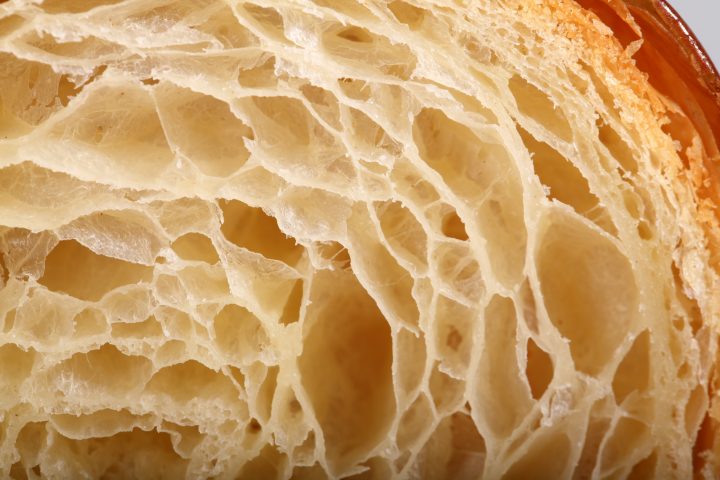
Baking croissants is always a work in progress, hopefully these answers are useful if you are up for the croissant baking challenge…
A lot of (first time) croissant bakers ask pretty much the same questions when tackling this challenging pastry. We composed a list of the top questions with our answers. Pretty sure your question will be answered here. Now lets get to the point of your very valid questions!
GENERAL RECIPE QUESTIONS
Why is your version a three day recipe?
The three day croissant recipe schedule is done for the right planning of the whole process so you can make your croissants on the third day in the morning, but of course you can take less time if this fits your timing better. Take a look at our one day version of this recipe too.
I am a first time croissant baker. What is your best advice?
Choose a cold day with a room temperature below 20 ºC / 68 ºF for your first attempt. This way you will have more time for the whole process and less chance of butter being absorbed by the dough. The key is to keep the butter solid between the layers of dough, this is what gives the croissant its flakiness.
My first attempt croissants look nothing like the ones in your pictures! What did I do wrong?
Do not expect to get perfect croissants the very first time you try to make croissants, most people need to make them 3 to 4 times to get the general feeling for the process. There is no substitute for practice and experience. There is no way to hide little mistakes in your technique when making croissants, so work very precise and follow the instructions to the letter. One small mistake is no problem but several small mistakes add up!
My croissants have a bread-like crumb and no layers. What did I do wrong?
Several factors can be the cause of this. Most likely it is an accumulation of things going sideways. It starts with pressing too hard on the dough to try and lengthen it while it is already fighting back. Keeping at this for a while means, next to the pressing on the dough, you are taking too long and the butter starts to get warm and is absorbed by the dough. So in this case, while still learning and getting better and faster, until you do make sure you build in extra fridge time to cool the dough and then continue. Handle the dough with care, gently elongate without pressing too much or putting your weight into it.
Can I turn your croissant recipe into a sourdough version?
We would recommend finding a recipe that is already a worked out version for sourdough croissants. We are not really a fan of the sour taste in pastry and for that reason we do not have enough experience to guide you to a good enough result.
Can you provide the measurements as ml, tsp, cups, instead of grams for all the ingredients?
We very much recommend weighing your ingredients. Professional bakers use scales (also in the US) and in Europe home bakers do too. A scale will give you the exact same weight every time. Which is absolutely needed if you consistently want to make good bread and especially good pastry. You can get a scale for the same price as a few sacks of good flour and less than a lot of baking tools you already own, so if possible, go and get one!
What are the measurements if I only want to make half of your recipe?
If you halve the recipe, the dough square should be 18.4 x 18.4 cm and the butter slab 12 x 12 cm.
Put the butter slab on top of the dough square and wrap the butter.
Roll the dough into a 20 cm x 30 cm rectangle.
Fold letter style to a 20 cm x 10 cm rectangle.
Turn dough 90 degrees.
Roll from the short 10cm side to a 20cm x 30cm rectangle (the short 10cm side will get 30cm).
Turn dough 90 degrees.
Roll from the short 10cm side to a 20cm x 30cm rectangle (the short 10cm side will get 30cm).
Turn dough 90 degrees.
Roll from the short 10cm side to a 20cm a 55cm rectangle (the short 10cm side will get 55cm).
The size of the final dough, right before cutting, should be 20 x 55 cm.
Although it is possible to use halve the dough we advise to make the full recipe as described in the recipe as the geometry of the shapes are much easier to work with.
You can always use halve and freeze the other halve.
I want to bake croissants, but live in a tropical location. Can I still make them?
We have gotten tips from people who have successfully baked croissants in the tropics. The top tips:
Cool ingredients and even utensils in the fridge before use, and use the fridge a lot to cool your dough and cool for longer if needed.
Roll the dough at night, when it is cooler. Check the weather reports and choose the coolest period possible.
BUTTER
My butter breaks into pieces. What should I do?
We use organic butter with a high fat content and low water content (about 82% fat). A higher water content tends to make butter hard, which promotes tearing and breaking and ruins the layers. Your butter needs to be pliable and at the same time not too soft at the moment of usage.
Help, butter leaks out when baking!
Your croissants were probably under-proofed. Just let them proof a bit longer so they get wobbly and increase visually in size. When under-proofed the butter tends to leak out from in between the layers and you end up with a butter puddle.
There’s so much butter in these croissants! Can I use less?
We would suggest making the recipe with the amount of butter indicated, enjoy the croissants and just try to eat less instead of a less than buttery croissant.
Next day eat soup and a salad.
FLOUR
Can I use another type of flour than the French type 55 you use?
For a good croissant you need the right type of flour. We have tried at least 5 different types and brands before we found a winner. If you cannot get the type 55 French flour try to find a flour with around 11% protein (this can be an all purpose / plain flour) and make sure it is a good quality flour. Try different brands if needed or use a combination of flours. Using 100% bread flour can make your result ‘heavy’ so try a combination with all purpose for instance.
DOUGH
My dough was too moist and sticky to handle. What should I change?
First of all it seems your flour absorbs less moisture than the type 55 flour we are using and you need to make adjustments by using a little less moisture next time.
My dough resists and shrinks back when I try to roll it out. What can I do?
At any stage when the rolling of the dough gets harder you can cover the dough and let the gluten relax for 10 to 20 minutes in the fridge before continuing.
If you keep on pressing the dough, trying to roll it while it resists, you will damage the layers!
SHAPING, PROOFING & YEAST
Can I use fresh yeast instead of instant yeast?
Yes you can. Use three times the amount given (so for our recipe 33 grams of fresh yeast).
Can I use active dry yeast instead of instant yeast?
Yes you can. Use 1.2 times the amount given (so for our recipe 13.2 grams active dry yeast).
At what stage should I add filling to my croissants?
You add filling just before the shaping / rolling up stage. Be aware that any filling will affect the layers and you will need less filling than you probably think. With chocolate for instance you will need no more than 5 to 7 grams per croissant. Professional bakers use stick chocolate for this, but you can use your own good quality (dark) chocolate. Fillings like jams are often added (injected) after baking.
I want to shape my croissants like a crescent. Why are your croissant not crescent shaped?
According to Raymond Calvel croissants laminated with margarine are formed into the crescent shape, while croissants laminated with butter are left in the straight form. We say, use whichever shape you like best, but do use real (organic) butter!
My croissants do not puff up like yours. What should I do?
First check the ‘sell by’ date on your packet of yeast and see if it is still OK to use it. Also make sure the temperature of your dough and proofing environment are correct.
Ideally you should proof the croissants draft-free at a temperature of 24ºC to 26.5ºC / 76ºF to 79ºF
BAKING
Why are my croissants under/over cooked?
Check the true temperature of your oven and see if any adjustments need to be made there. See our tips on the subject: Bread baking tips: Making the most of your oven.
Why are there pools of butter at the bottom of my baking pan when baking the croissants?
This could be a result of under-proofing, so make sure you proof at the right temperature and take the time to proof to perfection and get that nice wobble in your dough. It could also be you were not as meticulous as needed during the lamination process, so stick to the measurements, make sure they are as exact as possible, the edges are straight and follow our laminating instructions carefully.
Help my croissants split open during baking! What did you do wrong?
We suspect your croissants lack real layering and therefor are more bread-like with a lot of butter incorporated. Because they have this substance and are under-proofed and lack layering, you get an oven-spring during baking and the bread splits at its weakest points. With correct layering you get air pockets which will be able to expand and not rupture.
So try to work on your layering by keeping the laminated dough cool, work fast and do not press on the dough when rolling it but gently elongate it.
I want to freeze my croissants and bake at a later stage. What is the best way to do this?
Check out our tips for retarding and freezing with the one day version of our croissant recipe.
You can always find a way to adjust the recipe to fit your schedule.
What do I do to keep baked croissants fresh?
We would advice to put the croissants you do not eat on baking day in the freezer, after they have cooled. For extra flakiness and ‘almost as good as freshly baked’ you can put them into an oven for about 8 minutes at 175°C / 345°F, straight from the freezer.










Rajeshwari says
Hi,
Can I proof the croissant at room temperature for more than 5hrs?
Weekend Bakers says
Hello Rajeshwari,
If possible, you should stick to the times and temperatures given in our recipe. The chance of over-proofing is very high at 5 hours plus the quality of the dough will not get any better.
Will says
Hi! Thanks for the recipe, I’m in the middle of trying it for the first time now. For a home baker in a smaller kitchen, a 110 cm surface is hard to come by. Can I cut the dough in half before the final roll out step and roll out two sections to 55 cm each?
Weekend Bakers says
Hello Will,
Yes, at this stage it is no problem to make two sections.
Hope it will be good!
Betty says
I ordered frozen croissants, and they arrived all stuck together in one big glob! No more dry ice! Is there anything I can do to salvage the dough?
Weekend Bakers says
Maybe somebody has experience with this. We really do not know what you mean exactly with the dry ice bit…
Zai says
Your recipe says water, is it cold water or lukewarm? Does the dough slightly rise when in the fridge?
Weekend Bakers says
Hello Zai, you can take the water straight from the tap, so cold. The slight rise in the fridge is normal, just gently roll out the dough pushing any air out if needed.
Fatimah says
Hi what kind of sugar do you use? Caster or granulated? Thanks
Weekend Bakers says
Hello Fatimah,
The sugar we use ourselves resembles your granulated sugar most we think. You can use both types, no problem.
Enjoy your pastry baking
Suz says
Hi,
Great post and advice here!
I have made croissants before, but this time I’ve had to let the initial dough sit in the fridge almost 20 hrs (a long “overnight” stretch!) before “folding” the butter in. (recommended 8 hours, or overnight in recipe). Should I scrap that and start over? Will the dough still perform properly?
Thanks!
Weekend Bakers says
It depends Suz, has your dough dried out for example? There is only one way to find out and that is by handling the dough. If you want the result to be as good as possible, it is best to really stick to the recipe!
Daniela says
I left the croissant proofing enough and the butter is still melting Into the oven. What can I do? I don’t know how to solve this problem. It looks good but they are frying in the oven. Thank you
Weekend Bakers says
Hello Daniela,
Sorry to ‘hear’ this. A small bit of butter leaking is normal and it will partly be reabsorbed during baking. If you have larger puddles of butter then there is unfortunately still a chance the croissants were not proofed enough. The combination of time and temperature is important, not only that of the room, but especially that of the dough. Without being able to measure this, it is harder to judge if the croissants are proofed enough.
Hope you will give it another try and this batch still came out good enough to enjoy.
ralf westera says
How long or quick after proofing the croissants do I need to bake off the croissants? In other words, is it possible to proof the croissants on Monday evening and then bake them on Tuesday morning when waking up? Thanks so much, I love ur website!!!
Weekend Bakers says
Hello Ralf,
You can only postpone baking if you use your fridge or freezer.
How you can do this is explained by us at the bottom of our post of the one day croissant recipe:
www.weekendbakery.com/posts…nt-recipe/
And thank you for your kind words!
Margaret Lodge says
Why do my croissants unfold when proving.
Weekend Bakers says
We think you did not roll them up tight/ well enough or maybe your dough dried out too much from using too much flour. Brush off any excess flour before rolling them up too.
Eric Prater says
I’m making like my fourth or fifth batch. On the final roll out and turn a notice there were separate pieces of butter everywhere in my dough. I’ve never noticed that before is that, nor the way it should be? Or has my butter simply broken into pieces and just went randomly in through the dough
Weekend Bakers says
Hi Eric,
Did you maybe change the butter you used, a different type or brand?
Anastasia says
Hi! Thank you very much for this answers! I’ve made croissants a couple times and this is info will help me work on my mistakes.
This time I’m planning on making twice as much croissants as I did before, which will require to sheets of dough.
Can I store them in the fridge on top of each other after the last fold or will it ruin the layers?
Thank you so much!
Weekend Bakers says
Hello Anastasia,
For freezing we would advice our method as described at the bottom of the one day recipe (so freezing the shaped croissant works best in our opinion):
www.weekendbakery.com/posts…nt-recipe/
If you want to freeze the sheets it would be best to place them next to each other or in separate containers, if possible of course.
Freezing the already baked croissants works very well too.
Good luck with the baking and freezing!
Nadine says
What is the best temperature of the Paton for hand rolling?
Thanks so much!
Weekend Bakers says
Sorry Nadine, we are not sure about your question?
Silas says
Hi. I am halfway through my first attempt to make croissants and I have already encountered some problems:
1) The dough disc wasvery sticky when we took it out after the first overnight rest (using pure AP flour). Ended up having to reform it into a ball to roll it out into the 26×26 square. This also caused the dough to have some “creases” and may have caused issue 2B below. Will try to reduce the liquid as suggested above or use the 50/50 AP and bread flour mix during the next round. Please advise if there Is a suggested mount to decrease the liquid by?
2) Butter issues –
A. The butter (82% butter fat) is shattering inside the dough, and it’s also not reaching the shorter edges dough (I can see a small portion that at the short edges of the dough which do not have butter inside)
B. Towards the end of my first lamination, the butter was breaking through the dough. Not sure if it’s an issue of the dough or butter was starting to melt. But i believe it’s the former because there was butter still breaking out of the dough during the second lamination, after I rested the dough in the fridge for 20mins, used a cold rolling pin and was in an air conditioned environment.
Seeking some advice to resolved the above issues.
Thanks in advance.
Weekend Bakers says
Hello Silas,
Can we ask if this was your first try at making croissants or this recipe?
What do you mean by shattering? Is it breaking up in pieces? The butter should be pliable, but is your butter breaking up in pieces or dryer when you cut a piece off this butter?
Azinta says
I’ve had the same issue. My dough was stretchy. And after the initial fold, the butter wasn’t pliable I guess, so I could see it in pieces with gaps of dough in between.
And yes! This is my first time.
So when you say decrease the moisture, how much should I reduce my milk and water?
Also how do I know if the butter will be pliable before folding into the dough?
Weekend Bakers says
Hello Azinta,
Are you using the butter with the fat content of around 82% like we suggest using in the recipe?
You can already see this when you would cut of a chunk of butter, it should not break off but you should be able to put your knife through it more ‘smoothly’.
When decreasing moisture you should do this mainly by looking at how the dough comes together and keeping some moisture back, see if it needs more. The dough should absolutely not look dry, but should also not cling to the bowl. It depends on your flour how much it needs.
Eric Prater says
Got made this recipe for five times. Everyone who has tried them said they love them cuz they have come out pretty good. However I still have a question, how thick should my dough be on the phone roll out before cutting and shaping them?
Weekend Bakers says
Hi Eric,
If you stick to the exact measurements given in the recipe then the thickness should automatically be correct too. It is always hard to measure but the best indication we can give is between 3 and 4 millimeter or close to 0.15 inch.
Enjoy your croissant baking and sharing!
Nicole Heard says
I am wanting to make normal large size croissants.
What size do you cut the triangles.
What size is the base of each triangle and what size is the length/height of each triangle?
Weekend Bakers says
You can find all the measurements and the precise method of cutting and rolling with our recipe here Nicole:
www.weekendbakery.com/posts…nt-recipe/
The base is 12.5 cm and the length after elongating around 25 cm.
Chip says
Hi There! Thanks so much for an amazing recipe. I was hoping you could help me understand the dough a little better.
I’ve always been puzzled that for a croissant dough many recipes call for the “first proof” to happen in the fridge for several hours (~12 hours as in your 3-day recipe), when often a yeasted bread dough will have a first proof at room temperature for one or two hours (like in your one-day recipe).
What is happening to the dough during a slow and cold rest in the fridge that’s different from a faster room-temperature rest? Or is it just an adjustment for convenient timing?
Thanks for sharing your knowledge with us, it’s really rewarding being able to practice this recipe.
Weekend Bakers says
Thank you Chip,
Yes, these are choices in a recipe for convenience and handling. The fridge is used for retarding the development process and slowing down the yeast so the dough is still flatter (and colder) and easier to manage at the next stage. This is not to say you cannot do it quicker or different.
Look at the one day version of our croissants:
www.weekendbakery.com/posts…nt-recipe/
But the three day version is very well balanced and easy to manage for novice bakers too, so we would always recommend using this method to start with.
Enjoy the recipe and the results!
Onyinye says
I tried the croissants severally, but it didn’t come out nice, I don’t know what exactly went wrong. It looked like meat pie whenit came out of the oven.
Weekend Bakers says
We can advice you to read the answers to the general questions and also the comments with great advice for novice pastry bakers under the recipe for support:
www.weekendbakery.com/posts…nt-recipe/
Alyssa says
Hello,
Im in the process of making my first croissant and i popped a butter out of my dough, is it going to be fine? Thanks!
Weekend Bakers says
Hello Alyssa,
For a good croissant the lamination needs to be perfect, so the butter should be well sealed within the dough and not pop out. No worries, you will probably still get something you can eat and enjoy and you just have to keep practicing with your next batches.
Kathleen says
Hello,
I made my first croissants, thank you for the recipe! They were not perfect, but still delicious. Reading through the comments I think I did not prove them enough before baking. I am in Melbourne Australia, so it is quite cold here at the moment and I don’t have a proving draw. Great for the laminating process (which worked well on my very cold marble bench) but not so good for proving. How long can you leave them proving before they dry out? Should I cover loosely in clingfilm if leaving to prove longer than 3 hours?
Also, the flour I am using is 11-12.5% protein. The company also has a plain cake flour at 9.8% protein. Should I be mixing the two flours to get a mix closer to 11% or does it not really work that way?
Thanks again for your fantastic website!
Kathleen
Weekend Bakers says
Hi Kathleen,
We understand. Could you use your ever so slightly warmed up oven (then turn it off and never let it go over 26C) for at least part of the proofing? You are right about it taking too long and the possibility of drying out. A bit longer is no problem, but it should stay in the neighborhood of the 3 hours.
Yes, you can combine the two flours, it would be worth a try.
It will always be something you have to repeat several times with slight variations to see what works best.
It’s great that with your first attempt you already could enjoy good croissants. You should be proud and happy and take it from there 🙂
Enjoy the baking!
Marieke & Ed
Daniela says
I left my croissant proofing all night in the fridge and 3 hours in the morning out of my fridge and it looked proof enough but it’s still leaking in the oven. I tried everything and it’s still doing that. I live in a tropical weather for that reason I left over night in the fridge. Thank you for your suggestions.
Weekend Bakers says
Hello Daniela,
Could it be the croissants got too warm out of the fridge and that is why the butter leaked out? Try even longer fridge maybe and if possible measure the temperature of your dough if it is out of the fridge. It should never be over 26.5C.
Marisa says
Your tips are amazing!
I’d like to make croissants into a “bun.” I tried it rolling up the dough & cutting it into discs and putting it into a muffin tin. All my butter came out and it was bready. I think I didn’t have enough room for them to expand, but, I’m wondering if having the layers on its side, if gravity will melt the butter out regardless. Any thoughts there? Thanks!!!
Weekend Bakers says
Hello Marisa,
Sorry we cannot help you with this, we have no idea what you were doing or what your experience is with croissant baking. We would always say that it is fine to experiment, but first be sure you can make good plain croissants. Butter leakage can have so many causes, but now it is hard for us to say if it was the laminating, proofing or your ways of handling the dough or a combination that caused problems.
Romana Hajat says
Hi there, I am trying to make cornetti but the dough at the start doesn’t rise…it doesn’t seem to rise at all in fact which is very strange to me. I use the same yeast in various other recipes and it works fine. I also usually use a tiny amount of it and a long fermentation time and it’s fine! This recipe uses about 1 tbsp per cup of flour…I just don’t know why the rise would be inhibited?
Lo says
I’m having this exact problem right now. It’s been proving for over 2 hours and there’s no real rise.
Weekend Bakers says
See our answer to Romana. Also always check the date on the package and with pastry, open a new package at least, so you know you use it ‘fresh from the bag’ because it can lose some of its enthusiasm when it is not stored airtight.
If possible you can also try fresh yeast.
Weekend Bakers says
Hello Romana,
We understand. Some yeast has a problem with enriched dough (with lots of butter and sugar or other ‘enriching’ ingredients). We do not have this problem with our instant yeast, but we have heard this from some people. Maybe you can switch yeast brand (we do no Dr. Oetker works for instance if this is a brand you know) or use a yeast that is available especially for enriched dough.
Marilyn says
Can I use frozen stick of nutella for filling my croissant? Does affect the layer of it?
Weekend Bakers says
Hello Marilyn,
We expect you can. A filling will always affect the layers, so use a small amount if you want the effect to be minimal, especially when using something frozen inside. Just give it a try!
Marisa says
I tried a layer of marmelade… fail! 🙂
Weekend Bakers says
Add marmalade after baking by injecting it into the croissant.
Carol C says
Hi i have a question i shaped my croissant dough into a loaf by braiding them, it comes out beautifully at first after the bake, but when i take it out of the loaf pan. The sides tend to collapse onto itself, within minutes. Have you ever had that issue?
Weekend Bakers says
Hello Carol,
Sorry, we have never made a loaf with the croissant dough. We assume you kept a different / longer baking time for this loaf?
Carol says
Yes i did bake it for around 25minutes. I shaped it similar to a babka loaf
Weekend Bakers says
Hi Carol,
We think that might be a bit on the short side, maybe you should bake it for 10 to 15 minutes longer, because it is one big loaf.
mmir says
Hi.. i follwed exact recepi.. after removing frm the fridge when making into square there were some bubbles tht popped is it normal?… then i the dough was soo soft after so i had to fridge it more… then added the butter slab and laminate it and did the first roll to 20*60 but i notice there were more bubbles at both ends of dough and the butter accumulated around the dough bubbles and im afraid to roll more as it may pop and the butter may leak… so what went wrong? i live in malaysia actully and did this on a cold rainy day… i try to refrigerate often cause i realise butter melt easily.. i use 82%percent fat anchor Australia butter
Marilyn says
I had the same problem as well but my second attempt I put the dough in the freezer right away after I mixed all of the ingredients and shaped into a disc for 30 minutes to delay the fermentation then I moved my dough to chill overnight.
Weekend Bakers says
Hello Mmir,
It seems the yeast in the dough is already working enthusiastically, so we expect this has to do with the temperature and climate. For you it is cold and rainy but this might mean it is still over 25 C and very humid?
We like the suggestion that Marilyn gives to use the freezer might very well work for you too.
Good luck with it because we can understand it is an extra challenge to make pastry in tropical climates!
Ariel says
Hi! Thank you for the recipe! Tried it for the first time but my butter doesn’t elongate together with my dough when I roll it out. Is this because my butter was too cold hence hard?
Weekend Bakers says
Hello Ariel,
We provide you this answer that was given to the same question with the recipe by an expert home baker (we think it is very well put):
“I’ve seen a lot of questions lately about ppl being fearful of working with the dough, that the butter will “melt.” Please, don’t be afraid of the dough! Unless your kitchen is hot, you can work this dough without being so afraid! The flip side of this coin are the questions about seeing the butter break up, or break through the skin of the dough, or difficulty rolling it out. Well..that’s the balance only experience will provide you. I’m guessing most ppl refrigerate too much, actually, being so afraid of the dough that it makes the dough harder to work with. If the dough feels cool, the butter isn’t melting. Just shoot for cool, not freezing cold..maybe that will help..”
Kel says
why my croissant tear why proofing and baking?
Weekend Bakers says
We suspect it is a combination of different factors, especially if you are not yet a experienced pastry baker. The lamination can take too long, the type of butter and flour you use can be not quite right, the shaping that you did and proofing that is not quite there yet. The only thing we can always advice is practice and practice some more and you will get better and faster doing all the steps correctly and at the right speed. We can really recommend watching our video to see what it must look like. www.weekendbakery.com/posts…roissants/
Nikki says
The butter layer is breaking through the pastry on my third turn and along the sides of the pastry dough – why is this
Weekend Bakers says
What butter are you using? We think your dough might just be a bit on the cold side, so do not force the dough but wait a few minutes and try again.
CY says
Hi! I live in a warm tropical country and when I was proofing the croissants in my closed oven (with no heat or light on) the butter melted and pooled at the bottom of the croissants. I’m using kerrygold unsalted butter and heard that it melts at a lower temp than other butters (not too sure about this, got it from google, it’s my first time using kerrygold butter). Do you have any tips on how else I can proof the croissants in this climate? Thank you! (:
Weekend Bakers says
CY,
See our tips above. We also got these tips from a baker friend:
You can also cool your surface (if you don’t have blue ice packs) by placing a large, sided cookie sheet with ice on it, chilling your rolling pin, and pausing your rolling and putting the dough back in the fridge whenever you want. You can also splurge on the purchase of a marble or stone board to roll on, and chill that.
Other than that you also need to know if the oven or any other place in your home is the coolest place for proofing. Butter leeks out above 26C to 27C, so we think the main thing is to be able to measure the temperatures of your dough correctly and keep it on the right side of this figure. Good luck with it!
Lillie says
Thank you so much for this recipe! Really appreciate all the detailed steps and pictures. Been working hard on trying to make better croissants and I’m slowly getting there. After my n-th attempt, there was a huge gap in my croissant after baking. It looked ok in the oven but when I took it out to cool, I noticed shrinking/ peeling away between the top 2 layers. The bottom layers had nice lamination. What do you think could have caused this? Underbaking? over-development of gluten? Too much flour incorporation between the layers? Thanks for your help!
Weekend Bakers says
Hi Lillie,
A few questions: Did you see this in all croissants or just one? Did you change anything compared to your former bakes? Did you knead longer than usual? What oven setting did you use? Did you use ‘a lot’ of flour between the layers this time? Our initial thoughts go to underproofing and use of too much flour and possibly the not perfect shaping rolling up of the dough.
Lillie says
My former bakes all didn’t turn out well. They didn’t rise or puff, were very dense and chewy, so it’s hard to compare. My latest bake:
– I found that my previous dough was tough to roll out so I tried not to mix the dough too much to prevent gluten development (approx 3 min in the mixer) but I found this time my dough to be still dry and patchy so I sprinkled a little water until it was a bit better.
– I felt that I was fighting with the dough a bit when rolling it out especially on the last roll. I even let the dough rest 2x in between so I rolled it to a final size of 90cmx20cm and came out with 12 croissants.
– I did notice that my butter broke in the pastry this time. It didn’t bunch at the ends, but I noticed cracks in the butter through the dough
– Previously my pastry stuck to the counter and would rip when I rolled it out so I sprinkled a little more flour than before to prevent sticking
– For the shaping, previously I flattened the triangles with a rolling pin but thought I was breaking the lamination and preventing rise so this time, I just pulled gently to elongate the pastry before rolling into a croissant. I also tried not to push down on the pastry/ roll it too tight
– I proofed the croissants for about 2.5hrs until wobbly
– I baked in a conventional oven 390F for 9 min and then dropped it to 330F for another 9 min.
I hope you can decipher something from this. Thanks again for your help!
Weekend Bakers says
Hi Lillie,
We read your comment and the only thing you do not say in the end is how the result was this time! Seems like you made a lot of small improvements. Did you use the right butter with around 82% butter fat like we advice? You really need to pound on the butter like we show in our video, so you get a nice even pliable slab. Otherwise all the things you write sound good (like adding a bit more water because your dough needs it) or good enough to get decent croissants. So we hope you were already more pleased with this batch and are encouraged to go on to the next one.
Lillie says
Hi,
I used President butter as that was the only European butter I could find. I was definitely very happy with the outcome with puffy flakly layers. I just was just curious why I had a large whole inside my croissant where the top layer separated from the second layer.
Thank you!
Weekend Bakers says
We think this might be a possible result of the shaping. just pay extra attention to it next time.
Jessica says
My croissants tasted great, looked great, puffed, proofed, BUT the little holes in the interior were so much smaller than I see in pictures! The texture was slightly similar to a brioche. What’s the result of this? Is it just improper laminating? Not enough steam in the oven? Please help 😥
Weekend Bakers says
Hi Jessica,
Yes we think it is. When you use a bit too much time doing all the steps and the dough gets warmer, the dough will absorb the butter more and the croissants get a more bread like consistency. Practice and use the fridge more and it will get better we are sure!
Eurice says
My croissants are flaky but not golden brown? Can you please help me?
Weekend Bakers says
Hi,
At what temperature and what setting did you bake them? Did you use the convection setting?
Eurice says
Oh i use a stove oven. Do you have a specific temperature for this?
Weekend Bakers says
We assume you mean an oven that is part of a stove. Do you use a setting that is radiating heat or do you use a convection setting (hot air)?
If it is a normal household oven and you use the conventional setting (usually the symbol with two lines, one at the top and one at the bottom of a square) you should stick to the temperatures given in our recipe, unless there is something going on with your oven that makes it less hot than the temperature that is indicated on the panel. You can measure this with an oven thermometer.
Check our oven tips here:
www.weekendbakery.com/posts…your-oven/
Next to this be sure not to open your oven door during baking, you can lose a lot of heat that way. If you are not able to check the temperature, try starting the bake at a higher temperature next time.
Good luck!
Ava says
Thank you for all above advice, I now know why I didn’t get the flatness but I tried makeing almond croissants and losses the filling any advice thank you
Weekend Bakers says
Hi Ava,
We are not sure, we think this might have to do with the consistency of the filling. Which recipe did you use?
Kate says
Thanks for a great recipe. I’m finding that I’m getting fantastic visual layers on the outside however my croissants come out of the oven very flat. During the proofing the dough also seems to tear in places. I’m wondering if I’m not developing the gluten enough? or if I’m stretching the triangles too much when shaping. Any other thoughts? I’m so happy with the layers, each one is crispy and visible, but they still look average because they’re flat 🙁
Cheers!
Weekend Bakers says
What flour and butter are you using Kate?
Rita Fuan says
Can I use 2% milk instead of whole milk?
Weekend Bakers says
Hello Rita,
Yes, that is no problem.
Enjoy your pastry baking.